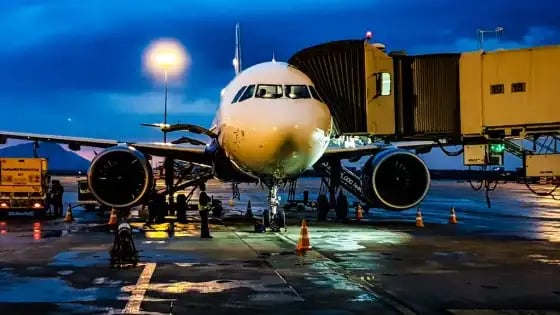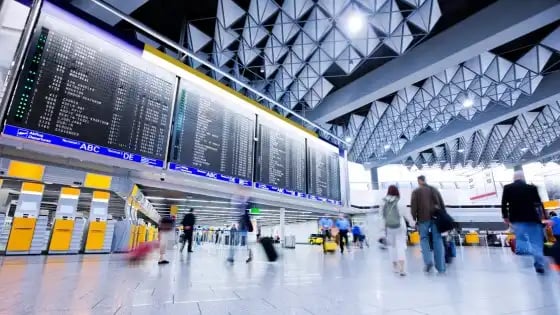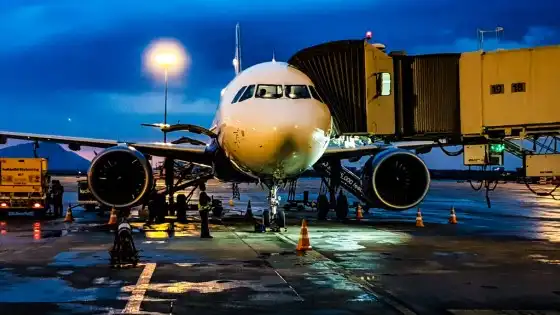
The aerospace industry has long been a champion of innovation. From making transcontinental travel easily accessible to helping humans land on the moon, aerospace engineers are known for finding and confronting new frontiers. Today, aerospace robots are the latest frontier being explored and leveraged by this innovative industry.
"Robot manufacturers and integrators are shaking up a number of industries in their own ways," said Spatial NAM Sales Director, Purkhet Abderyim. "The aerospace industry is certainly no different."
What are aerospace robots? How are they being used by aircraft designers and manufacturers? In this blog, we’re taking a closer look at how robots are shaping the future of aerospace technology.
What Are Aerospace Robots?
Aerospace robots are industrial robots designed to assist people and manufacturing processes in the aerospace industry. They range from robotic arms used in production assembly lines to autonomous drones used for aerial surveys and inspections.
A Brief History of Aerospace Robotics
For decades, movies and science fiction authors have depicted aerospace robots as everything from friendly sidekicks to deliverers of doomsday. However, in reality, they are used for precision manufacturing, research, and ensuring stringent quality standards are met - as well as other purposes.
Below is a brief overview of their history.
- Early beginnings: The use of robotics in aerospace can be traced back to the 1960s, with the advent of automated machines for repetitive tasks in aircraft manufacturing.
- Space exploration: The 1970s and 1980s saw the introduction of robotic systems in aeronautics, such as the Canadarm, which was in use from 1981 - 2011.
- Modern applications: Today, aerospace robots are used in a variety of applications, from manufacturing and maintenance to research and development.
How Are Aerospace Robots Being Used?
In any industry where efficiency, safety, and precision are essential, robots can easily play an integral role. That’s why robots are a natural fit for aerospace companies. Not only do they add efficiency and increase productivity for aircraft manufacturers, but they also open new avenues for innovation and advancement in all areas of the industry.
Below are just a few examples of aerospace robots:
Manufacturing and Assembly
The manufacturing and safety regulations when building an aircraft are notoriously strict. If a piece of equipment made for use in the aerospace industry is found to be out of spec - by even a minute margin - it could ground all aircraft containing equipment produced from that batch.
By using robots, manufacturers can ensure precise measurements and specifications are met more easily and with greater efficiency. This is beneficial in several manufacturing areas. Aerospace robots can perform complex tasks that can include:
- Welding
- Drilling and fastening
- Part installation
- Engine paint and coating applications
- Part assembly
Automation of Air Traffic Control
Helping airplanes take off and land safely and on-time has always been a challenging endeavor. Automated robots can help air traffic controllers (ATC) manage this critical function more efficiently.
At London’s Heathrow Airport, robot applications are being used to aid ATC operations. These initiatives are helping one of the world’s busiest airports to speed up ATC processes and enhance vision systems.
Inspection and Maintenance
Inspection and maintenance processes are of critical importance in the aerospace industry. As seen in the above section, if inspections aren’t performed properly, there’s an increased risk that an aircraft could cause injury, property damage, and lost revenue. Fortunately, such risks can be managed with the help of robots.
Aerospace robots are becoming invaluable for inspection processes and maintenance tasks. They can access hard-to-reach areas, identify potential issues, and even perform repairs. This proactive approach reduces downtime and ensures aircraft are safe and ready for operation.
For instance, with the use of robots, Spirit AeroSystems can complete its quality control inspections on large, composite aircraft components in 40% less time than it did without robots. It also gives them the ability to adapt to new quality control parameters easier, faster, and for less cost.

Passenger Care and Safety
Getting people where they need to go in an airport takes a great deal of care and consideration. Airports are increasingly relying on robots to help provide efficient, timely care to their travelers as well as improve safety checks.
Heathrow Airport has enlisted the services of cleaning robots that disinfect high-traffic areas with UV light. In Qatar’s Hamad International Airport, a security robot is helping security personnel identify suspicious travelers, detect fake credit cards, carry out face recognition, and more.
7 Benefits of Aerospace Robots
Aerospace robots offer a multitude of benefits for aerospace engineers, aircraft manufacturers, and travelers. They can enhance operational efficiency, improve public safety, and further new innovations more quickly. Robots are allowing people to take significant leaps forward in how the aerospace industry operates.
Seven key benefits of using aerospace robots include:
- Increased efficiency: Robots can work around the clock. This increases production times, reduces bottlenecks, and reduces labor costs.
- Enhanced precision: Robots can perform tasks with a level of precision that can surpass human capabilities.
- Improved safety: Robots can handle hazardous tasks, monitor safety risks, and not make mistakes due to fatigue thereby reducing the risk of accidents and injuries.
- Cost savings: Robots can reduce labor costs and increase productivity, leading to significant cost savings for manufacturers and product developers.
- Greater flexibility: Robots can be quickly reprogrammed to perform different tasks when changes to design arise or for small batch manufacturing, offering a new level of flexibility.
- Quality assurance: Robots can perform with advanced consistency and precision. This increases quality assurance results and reduces human-led errors when performing tedious, repetitive tasks.
- Innovation and advancement: Robots, and the software that drives them, open up new possibilities for innovation and advancement in aerospace technology.
Looking ahead, the role of robots in the aerospace industry is set to grow. As demand for global travel and international commerce continues to grow, the aerospace robotics industry will continue to provide innovative and impactful solutions to meet demand.
Build Leading Aerospace Robots With Specialized Software Development Kits
Undoubtedly, robotics will continue as a major driver of innovation within the aerospace industry. Robotics are already helping to build planes faster, enhance air traffic management, and streamline passenger care. At Spatial, we’re experts in robotics software development kits that are helping aerospace innovators develop and deploy modern robots in their industry.
How do Software Development Kits (SDKs) enhance today’s aerospace robots?
Shorten Time-to-Market for New Products
Robotics SDKs streamline the development process, enabling faster prototyping and testing. This accelerates the time it takes to bring new robotic solutions to market, allowing aerospace companies to enjoy revenue faster on new products and gain a competitive edge.
Optimize robotic tool developments with SDKs. Learn more in our blog:
Meet Increasing Production Demands
As the demand for aircraft continues to grow, so does the need for efficient production methods. SDKs empower developers to create robots that can scale with these demands, automating complex tasks to significantly boost production rates.
These robots not only increase production capacity but also maintain the high-quality standards required in the aerospace industry. This ensures that quality control measures are maintained even as production scales up.
Increase Prototyping Efficiency
SDKs allow developers to simplify and expedite the prototyping process. Developers can quickly iterate on designs, test functionalities, and refine their robots before deployment. This not only saves time but also ensures that the final product meets the high precision needs of the aerospace industry.
Customize Applications
Spatial's SDKs offer aircraft manufacturers the flexibility to create custom robotic applications and automate workflows that are tailored to their specific requirements. For instance, optimizing a robot for use in precise inspections of proprietary engine parts can be done faster and for less money with an SDK.
The Sky's the Limit: The Future of Robotics in Aerospace
The amount of progress seen in the aerospace industry in the past few decades is staggering. It’s hard to imagine how different aircraft and air travel will look in another 50 years. However, we are certain that robots will play an important role.
Building applications to make robots easier to develop, more efficient, more productive, and easier to use is what we do at Spatial.
For more information on how to develop your application for aerospace robots, reach out to our team.

